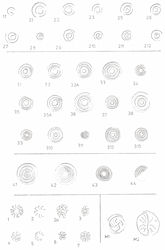
The first major period of stamp usage during the Roman period occurred during the late 1st and early to mid-2nd centuries AD and was mostly focused in the south-east of Britain. The main production centres appear to have been in Essex, north-west Kent and Suffolk. Parisian Ware was also produced during this period, but because its potters do not appear to be influenced by what was going on elsewhere in Britain, I shall discuss this later.
'London Ware' is a term that describes a distinctive type of decoration on a range of forms (generally bowls inspired by samian prototypes) and usually made from a fine-textured grey or black fabric (Tyers 1996). Jason Monaghan described the designs as 'using compass-scribed circles and semi-circles plus incised parallel lines and bands of rouletting' (Monaghan 1987, 174). They appear to have been made at a number of sites across eastern and southern England during the 2nd century AD. Geoff Marsh noted that production sites had been identified in the Nene Valley, Suffolk, Essex, Kent, Oxfordshire and possibly in West Sussex and remarked:
'The term "London Ware" should perhaps only be used for vessels that can be shown to have been produced in the London area ... In general, it seems unlikely that vessels from London travelled more than c. 30 miles from their source.' (Marsh 1978, 124)
The Upchurch and Thameside Kent and Essex production centres, which were at their height in the late 1st and 2nd centuries, certainly produced a fineware resembling 'London Ware', although Monaghan commented: 'It would not be correct to say that the Upchurch potters manufactured "London Ware", but it would be acceptable to say that some of their products were in the same style.' (Monaghan 1987, 174)
The only overview of stamping in eastern England in the early Roman period was published by Warwick Rodwell (1978), and was based on his study of more than 200 stamped vessels. Although more comprehensive studies of particular production centres have been published since then, no-one has produced a more up-to-date Corpus or attempted to update his study.
Rodwell identified three motif groups: ring, block and rosette stamps (Figure 3). These could be found on their own or in association with another group, allowing him to develop a die-link matrix (Rodwell 1978, fig. 7.21). Rodwell's R1.1 to R2.12 and R4.1 to R4.4 motifs parallel the various ring motifs from the La Tène tradition. However, the motifs are so simple and so universal that it is highly unlikely that any inspiration from the past was required. Rodwell's Ros-1-2, 5 and 7 motifs parallel some of the La Tène rosette motifs, and are also comparable to Elsdon's Parisian Ware R2 motif (Elsdon 1982, 11, fig. 5).

Rodwell's matrix analysis of these motifs allowed him to attribute vessels to one of eight production areas, as follows:
Numbers 4-8 form sub-groups of the East Anglian wares category. There were also some 13 examples that did not fit into any of the above and which he classified in two 'Miscellaneous' groups. Rodwell's most interesting group from the point of view of this study is Group 3b from the North Essex Wares. This consisted of 'a group of bowls which bear rosette stamped decoration' (Rodwell 1978, 247). He dismissed Hadham as their point of manufacture and wondered if Colchester was not more likely. There was little dating evidence and he could 'do no more than hazard a guess at an early second-century date for Group 3 as a whole' (Rodwell 1978, 248). The Ros-1 and Ros-5 motifs both fall into the A 5d Sub-type, while the Ros-2a appears to be an A 5fi.
This tradition was first identified and named by Philip Corder in a short article, that illustrated some of the stamps and vessels that he had collected from various sites in East Yorkshire (Corder 1956). He noted that many of these sherds were unstratified, but those that did have related stratigraphy appeared to date from the late 1st or early 2nd century before c.AD 120 (Corder 1956, 50). However, the name is misleading, given Elsdon's identification of the core region as follows:
'The core region to be considered in detail comprises the present counties of Lincolnshire, Humberside with parts of Nottinghamshire and South Yorkshire. Here, there is a strong tradition of stamped decoration on fine wares, both in the early period and continuing, on different forms at least into the third century AD.' (Elsdon 1982, 1)
She also commented that 'the date range is much wider than Corder originally thought' (Elsdon 1982, 8). The early Parisian Ware was originally dated from around AD 65 to 140, but the start date is now considered more likely to be around AD 75 (Elsdon 1982, 14). The later Parisian Ware is now dated from around AD 140 to the late 3rd or even early 4th centuries.
By March 2014, I recorded 336 examples of stamped Parisian ware in the Archive of Roman Pottery Stamps (hereafter ARPS) from 60 sites using 100 different motifs. The A 5 Types represent just over 10 per cent for Parisian Ware against just under 17 per cent overall in the 4th century, although it is interesting that both periods show a bias towards the A 5a, A 5d and A 5f Sub-types. Most of the A 5d examples come from Yorkshire (Rossington Bridge, Brough-on-Humber, Rudston Villa and the fort at Piercebridge), with other examples from Greta Bridge (Co. Durham), Dragonby and Lincoln. The A 5fi motifs, by contrast, show a bias towards northern Lincolnshire (coming from Dragonby, Hibaldstow, Kirmington, Lincoln, Old Winteringham and two sites in Market Rasen). The only examples in Yorkshire come from Rossington Bridge.